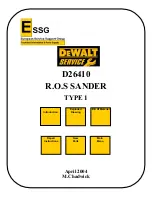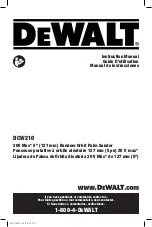
WARNING
Injuries may be caused or aggravated by prolonged use
of a tool. When using any tool for prolonged periods,
ensure you take regular breaks.
KNOW YOUR PRODUCT
See page 6.
1. Turn off
2. Variable speed control selector
3. Turn on
4. Cover
5. Finger pad
6. Lock
7. Dust collection box
8. Delta pad
9. Paper Clamp
10. 1/3 Sheet pad
11. Hex key
12. Adhesive sandpaper
13. Non-adhesive sandpaper
14. Insulated grasping surface
SANDPAPER SELECTION
Selecting the correct size, grit and type of sand paper is an
extremely important step in achieving a high quality sanded
finish. Aluminum oxide, silicon carbide, and other synthetic
abrasives are best for power sanding. Natural abrasives,
such as flint and garnet are too soft for economical use in
power sanding.
In general, coarse grit will remove the most material
and finer grit will produce the best finish in all sanding
operations. The condition of the surface to be sanded will
determine which grit will do the job. If the surface is rough,
start with a coarse grit and sand until the surface is uniform.
Medium grit may then be used to remove scratches left
by the coarser grit and finer grit used for finishing of the
surface. Always continue sanding with each grit until
surface is uniform.
WARNING
Do not use sander without sandpaper; doing so will
damage the cushion.
Sheet/pad recommended use
80-grit sanding sheet
Coarse sanding
120-grit sanding sheet
Light sanding
150-grit sanding sheet
Light sanding
MAINTENANCE
WARNING
The product should never be connected to a power
supply when assembling parts, making adjustments,
cleaning, performing maintenance, or when the product
is not in use. Disconnecting the product from the power
supply will prevent accidental starting that could cause
serious injury.
WARNING
When servicing, use only original manufacturer’s
replacement parts, accessories and attachments. Use of
any other parts may create a hazard or cause product
damage.
WARNING
Do not at any time let brake fluids, gasoline, petroleum-
based products, penetrating oils, etc., come in contact
with plastic parts. Chemicals can damage, weaken or
destroy plastic which may result in serious personal
injury.
■
Avoid using solvents when cleaning plastic parts. Most
plastics are susceptible to various types of commercial
solvents and may be damaged by their use. Use clean
cloths to remove dirt, carbon dust, etc.
■
Always wear safety goggles or safety glasses with side
shields during power tool operation or when blowing
dust. If operation is dusty, also wear a dust mask.
■
If the supply cord is damaged, it must be replaced
by a special cord or assembly available from the
manufacturer or its service agent.
■
For greater safety and reliability, all repairs should be
performed by an authorised service centre.
WARNING
Electrical tools used on fiberglass material, wallboard,
spackling compounds, or plaster are subject to
accelerated wear and possible premature failure
because the fiberglass chips and grindings are highly
abrasive to bearings, brushes, commutators, etc. We do
not recommend using the product for extended work on
these types of materials.
WARNING
Do not use compressed air to blow dust from the product.
This practice is dangerous and can cause dirt and grit to
be blasted into someone’s eyes, causing injury.
LUBRICATION
All of the bearings in the product are lubricated with a
sufficient amount of high grade lubricant for the life span of
the product under normal operating conditions. Therefore,
no further lubrication is required.
3
Содержание RMS180
Страница 1: ...ORIGINAL INSTRUCTIONS Multi pad Sander RMS180...
Страница 7: ...5...
Страница 8: ...6 4 5 11 12 6 7 3 8 10 13 14 9 2 1...
Страница 9: ...1 2 1 2 1 2 5...
Страница 10: ...7 3 2 2 1 6 1 3 4...
Страница 11: ...8...
Страница 12: ......
Страница 13: ...9 1 2 1 2 3 1 2 1 2 1 6 1 2 a b 3 4...
Страница 14: ...10 3 1 2 2 1 5 6...
Страница 15: ...11 1 2 2 1 2 1 2 3 4 1 2 1...
Страница 16: ...12 2 1 2 1 5 6 7 8...
Страница 17: ...13 2 1 10 2 1 11 1 2 9 12...
Страница 18: ...1 2 1 2 1 2 3 4 20190124v3 14...






































